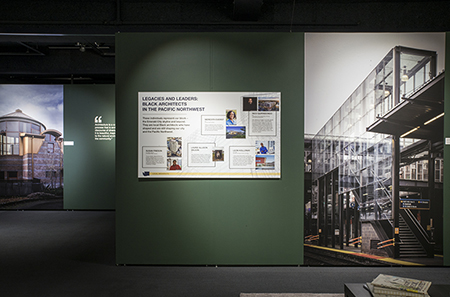
Continuing through April 30, 2023
Considering that most of the original government buildings in Washington, DC were built by slave labor, as were other private and public structures — such as city halls and post offices — throughout the South and North, it is highly appropriate that “From the Ground Up: Black Architects and Designers” chronicles the legacy of those mostly anonymous builders. Historic Black colleges made a point of creating architecture programs for interested students as early as 1923, when Hillyard Robinson became professor of architecture at Howard University. Before and after that, African American architecture students were welcomed at University of Southern California, Columbia University, University of Illinois, City College of New York and, most importantly, Harvard.
Everyone has heard of Cesar Pelli, the architect credited with the Pacific Design Center (or “Big Blue Whale”) in West Hollywood, but who knew that Norma Merrick Sklarek, a Black woman, supervised the design and construction processes? Or that LBJ’s favorite architect, Edward Durrell Stone, was indebted to Beverly Greene for his design of the Sarah Lawrence College Fine Arts Center? Or that Marcel Breuer also owed Greene a lot for the UNESCO building in Paris? Filled with such revelations, this traveling exhibit, originally organized at the Museum of Science & Industry in Chicago, is both salutary and educational.
Although he did not study with Walter Gropius, Robinson’s Langston Terrace Housing in Washington, DC was built according to Gropius’s Bauhaus housing models, but Robinson faced them with a more hospitable red brick. More recently, the 9/11 World Trade Center Memorial Museum in Lower Manhattan, designed by J. Max Bond, Jr. attracted attention with its subterranean site and ins incorporation of remaining ruins and footprints of the twin towers. Bond eventually became Chair of Columbia’s graduate school of architecture.
Many of the pioneers faced considerable discrimination from the field’s elite white clients and turned instead to Black-financed educational and residential facilities. Moses McKissack III, at Fisk University in Nashville, is a link to the slave laborers of the early Republic in that his first jobs were constructing “shot gun houses” in Tennessee. Ironically, McKissack, licensed in 1922 without a degree, gained his initial reputation from designing Colonial-style brick houses for white professors at Vanderbilt University. McKissack’s grandchildren continue his practice today. Other prominent designers who faced segregation simply left. Georgia Brown moved to Brazil, where she became a leading advocate for the International Style, incorporating indigenous touches to public buildings and houses.
Among the 24 architects covered in the MOHAI survey are nine women, heralded as practitioners, government planners, and academics. Tiara Hughes worked for Skidmore Owings Merrill on international projects while Kimberly Dowdell just recently designed the Qatar Airport. Besides Greene and Sklarek, younger architects like Roberta Washington have changed the face of Harlem. Her renovation of the US Embassy in Port-au-Prince, Haiti is also noteworthy.
Helpful timeline panels date Black architecture as far back as the Great Pyramid of Giza; the proto-urban structure of Great Zimbabwe; the Dogon Cliff Caves; and what may be the first structure in North America designed by an architect of African heritage, the Dolliole Cottage in New Orleans, built in 1820 by the Creole designer Jean-Louis Dolliole.
Educated at the Royal College of Art in London, Sir David Adjaye was lead architect on the new Smithsonian National Museum of African American History and Culture in DC. He has also adapted African building methods to imaginative ends with his Mole House and Sunken House, private homes in London. Another prizewinner, Germane Barnes, teaches at University of Miami and garnered a Wheelwright Prize for international travel, along with the coveted Rome Prize, when he left Harvard.
Paul Revere Williams is often referred to as “architect to the stars,” a Hollywood label that obscures his numerous other equally significant projects. A USC dropout in 1919, Williams went on to design homes for the likes of Lucille Ball and Frank Sinatra. His larger St. Jude’s Hospital in Memphis was commissioned by Danny Thomas. Los Angeles International Airport’s “Theme Building,” with its futuristic parabolic roof, was also designed by Williams, who is arguably the most noted Black architect in America. Only recently honored with a huge monograph, Williams is now seen as a precursor to the revivalist, pluralistic side of post-modernism.
This is an excellent survey, well supplemented with informational plaques, maquettes, and video interviews, notably with ten Pacific Northwest architects of African origin who are given nearly one-third of the gallery space. But given its national range, viewers can now see how the architectural history of America cannot be written without the contributions of Black builders, architects, and designers, from the dawn of the republic right up to the present moment.
